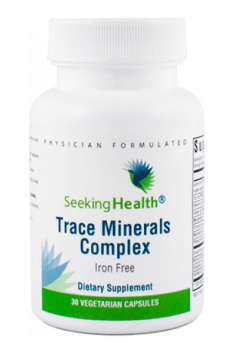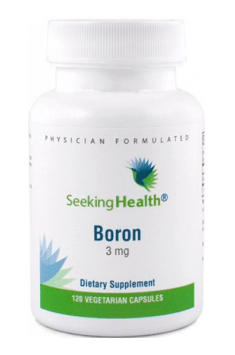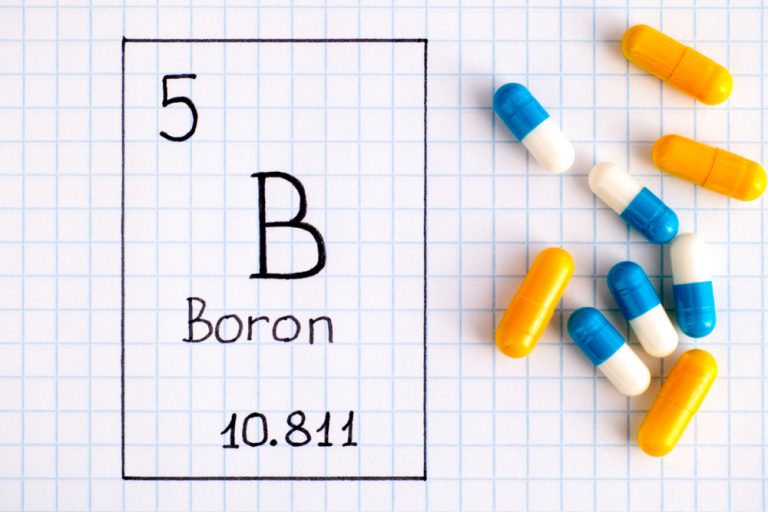Boron is a supplement that can improve our health on many levels. It can help build strong bones and muscles, improve cognitive functions and even cure infections. In the following article we will try to bring you this supplement, the power of its positive properties, the way it works and potential side effects.
Boron - basic information
Boron is a mineral that has become very loud in recent years. It systematically gains popularity around the world. His ability to support the treatment of arthritis, certain cancers, menopause and a positive effect on testosterone levels has initiated a number of studies. Boric acid is one of the forms of boron, which also contains many unusual, health-promoting properties. Below, we present you the results of research on the positive effects associated with the use of boron supplements, as well as possible, unwanted side effects.
Health benefits resulting from boron supplementation:
1) Boron improves bone health
Boron levels in patients with arthritis were significantly lower than in patients who did not have this disease. Boron supplementation strengthens bones and joints, accelerates healing of broken bones and helps to prevent arthritis (1). The US Department of Agriculture conducted an experiment in which menopausal women took 3 mg of boron per day. The results showed that boron supplementation reduced the calcium excretion by 44% suggesting a possible role in inhibiting osteoporosis (2). Boron supplementation increases bone mineral density (3). Boron improves calcium metabolism in people with post-menopausal deficiency (4).

2) Boron has anti-inflammatory properties and helps in the treatment of inflammatory joints
Several studies have shown a reduction in pain in patients with arthritis after the administration of a boron supplement. In areas of the world where the boron consumption is usually 1.0 mg or less / a day, the estimated incidence of arthritis ranges from 20 to 70%. In areas of the world where the boron consumption is between 3 and 10 mg, the estimated incidence of arthritis ranges from 0 to 10% (5). Boron increases the secretion of chemical mediators of inflammation, which helps in the healing and regeneration of cells and in the reduction of inflammation (6). Boron induces the growth of anti-inflammatory and phagocyte-containing nutrient cells that help fight infections. Stimulation of these cells triggers an increased immune response (7).
3) Bor supports the fight against cancer
Prostate specific antigens (PSA) are associated with an increased level of IGF-1, which causes tumor growth (8). It has been found that boron is a serine protease inhibitor, in particular PSA (9). In mice, boric acid significantly reduced the level of PSA and IGF-1 in the tumor (10). The drug for chemotherapy, Bortezomib, contains boric acid and has been approved by the FDA for the treatment of multiple myeloma (plasma cell carcinoma). This drug sensitizes cancer cells to apoptosis (cell suicide) and increases sensitivity to other chemotherapy drugs (11).
It was also found that boric acid supports resistance to DNA damage that can cause cancer (12). Borre Neutron Capture Therapy (BNCT) has been discovered in new research aimed at destroying cancer cells without killing surrounding healthy cells (13). It has been proven that injection of boron inhibits growth and reduces the size of tumors in mice. This is done by using large amounts of boron to induce cell toxicity, ultimately killing cells (14). In mice with melanoma, this method also gave a sustained survival compared to those who were not treated (15).
4) Bor increases the level of free testosterone
Boron-containing dietary supplements increase the overall level of testosterone by increasing the levels of steroid hormones in the blood (16). This can help athletes improve their performance and overall physical strength (17).

5) Boric acid can treat yeast infections
Boric acid is a popular way to treat vaginal infections. Boron is used to kill yeasts and prevent relapse (18).
6) Bor helps in getting rid of kidney stones
10 mg of boron per day increased the rate of excretion of the kidney stone. It also reduced the level of pain felt (19).
Summary:
Boron stimulates the secretion of TNF-α, IL-6, IL-1β, NO and expression of iNOS by macrophages with the LPS primer. The effect was dose-dependent and most significant at a dose level of 4.6 mg / kg body weight.
Boron induced a dose-dependent increase in antigen-induced (OVA) splenocyte proliferation, measured by change in absorbance at 570 nm, showing a maximum increase (1.66 ± 0.08) at a dose of 4.6 mg / kg body weight, compared to the stimulated group (0.92 ± 0.03) (21). A single-blind cross-over assay resulted in a significant increase in plasma levels of 17-B estradiol (E2) (P <0.004) and a tendency to increase testosterone (T) in plasma was observed.
In addition, the measurement of glucan synthase activity in the membranes of strain YPH499 showed a steady decrease with increasing BA concentration.
Food sources
Boron occurs naturally in many foods found in a standard diet. This includes fruits and vegetables such as apples, dates, plums, raisins and many nuts.
Dosing of boron
The normal dose is 3 mg a day. The American National Institute of Health claims that "The total daily intake of boron in a normal human diet ranges from 2.1-4.3 mg boron / day." The recommended dose of boron has not been determined. For caution, adults should not take more than 20 mg per orally. In case of vaginal infections, women should use only 600 mg of boric acid powder once or twice a day.
Potential side effects
Boron has no long-term side effects. Boron toxicity is rare, because the body easily removes excess of this mineral. Symptoms include problems with the gastrointestinal tract, irregular menstruation and seizures.
Bibliography
- http://www.ncbi.nlm.nih.gov/pubmed/7889887
- https://en.wikipedia.org/wiki/Boron
- http://www.ncbi.nlm.nih.gov/pubmed/7889886
- http://www.ncbi.nlm.nih.gov/pubmed/2222801
- http://www.ncbi.nlm.nih.gov/pubmed/7889887
- http://www.ncbi.nlm.nih.gov/pmc/articles/PMC4774930/
- http://jnci.oxfordjournals.org/content/92/18/1472.full
- http://www.ncbi.nlm.nih.gov/pmc/articles/PMC2675663/
- http://www.ncbi.nlm.nih.gov/pubmed/14713551
- http://www.ncbi.nlm.nih.gov/pubmed/15930333
- http://www.ncbi.nlm.nih.gov/pmc/articles/PMC2063329/pdf/brjcancer00182-0042.pdf
- http://www.ncbi.nlm.nih.gov/pubmed/1778174
- http://www.ncbi.nlm.nih.gov/pubmed/10376277
- http://www.ncbi.nlm.nih.gov/pmc/articles/PMC3017954/
- http://www.ncbi.nlm.nih.gov/pubmed/22385047
- http://www.ncbi.nlm.nih.gov/pmc/articles/PMC4774930/
- http://www.ncbi.nlm.nih.gov/pubmed/10376277
- http://www.ncbi.nlm.nih.gov/pmc/articles/PMC3017954/
- http://www.greenfacts.org/en/boron/toolboxes/2.htm#a0







One Comment